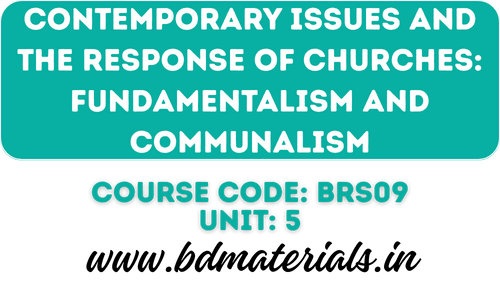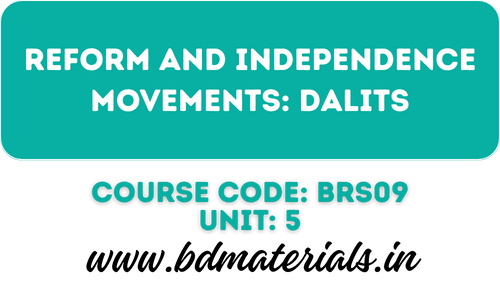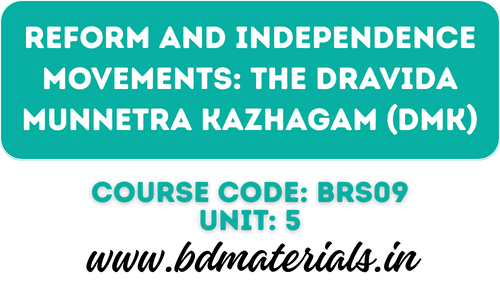Sarvodaya Movement
Sarvodaya Movement
Sarvodaya is a term meaning ‘Universal Uplift’ or ‘Progress of All’. ‘Sarvodaya’, the word, in ancient literature, might have been used in some context, but its use as a definitive philosophy is only 100 years old. This word took shape in Gandhi’s mind in 1904 when he read Ruskin’s book ‗Unto This Last’, but the word took concrete shape in 1908 when Gandhi translated the gist of this book in Gujarati. The translation is an example of Gandhi’s literary acumen. The title of Ruskin’s book was taken from a Biblical story ‗Unto This Last’, which means that even the last person should get an equal share. In those days, the concept of ‗Greatest good of greatest number’ was in vogue. But Gandhi said that Sarvodaya meant the rise of all, and it was not merely the greatest good of the greatest number or of the last person standing in the queue. From then on, the ideology of Sarvodaya got firmly established in social discourses. The detailed explanation of the meaning of Sarvodaya can be found in ‗Hind Swaraj’ that was written by Gandhi in 1909. Gandhi advances the concept of Sarvodaya, which were based on three basic principles:
- That the good of the individual is contained in the good of all.
- That a lawyer’s work has the same value as the barber’s in as much as all have the same right of earning their livelihood from their work.
- That is a life of labour, i.e., the life of the tiller of the soil and the handicraftsman is the life worth living.
―The first of these I knew. The second I had dimly realized. The third have never occurred to me. ‘Unto This Last’ made it clear as daylight for me that the second and third were contained in the first. I arose with the dawn, ready to reduce these principal to practice.
Sarvodaya Movement in India
The Sarvodaya Movement originated in India in the early 1920s and it was an extension of the work which Gandhi had originally started in the name of constructive programme. According to Ostergaard, the Sarvodaya Movement in India represents an attempt to apply to the task of social reconstruction the ideas originally developed by Mahatma Gandhi. Sarvodaya Movement is a people’s movement to carry forward the ideas and programmes sponsored by Gandhi for the welfare of all and the awakening of all.
The foundations of the Sarvodaya Movement have been firmly laid by Gandhi based on the principles of truth, non-violence and love, all of which have eternal value. Gandhi’s concept of Sarvodaya emphasizes the survival and development of all. ―It contains various concepts like Satya, ahimsa, decentralization, antyodaya, small but face to face communities, dignity of labour, and bread labour, limitation of wants, simple life in tune with nature etc.
The goal of Sarvodaya to say in simple terms, is to establish a peaceful society, where there will be no exploitation of any kind, economic, social, political or cultural. In such a society every individual, big or small, rich or poor, weak or strong will have equal opportunities for all-round development. This is what Sarvodaya means, ‗welfare of all’. The Sarvodaya concept also specifies that for achieving good ends, only good means should be adopted. Good means the path of love, truth and non-violence.
Gandhi’s ideals have lasted well beyond the achievement of one of his chief projects, Indian independence (Swaraj). His followers in India (notably, Vinoba Bhave) continued working to promote the kind of society that he envisioned, and their efforts have come to be known as the Sarvodaya Movement. Anima Bose has referred to the movement’s philosophy as ―a fuller and richer concept of people’s democracy than any we have yet known. Sarvodaya workers associated with Vinoba, J. P. Narayan, Dada Dharmadhikari, Dhirendra Mazumdaar, Shankarrao Deo, K. G. Mashruwala undertook various projects aimed at encouraging popular selforganization during the 1950s and 1960s, including Bhoodan and Gramdan movements. Many groups descended from these networks continue to function locally in India today.
Objectives of Sarvodaya Movement
The Sarvodaya Movement has as its target the establishment of a whole network of such self-supporting village communities. The family relationships which are confined at present to the blood group will be extended to cover the whole village where distinctions based on race, creed, caste, language and so forth will completely be eliminated. Agriculture will be so planned that all the people will have enough to consume. Industry will be conducted on a cottage basis till all the people in the village are gainfully employed. The needs of the village will be determined by the people of the village themselves, through Village Council, representative of the whole village.
Principles of the Sarvodaya:
- There is no centralized authority, and there is political and economic atmosphere in the villages.
- Politics will not be the instrument of power but an agency of service and Rajnity will yield place to Loknity.
- All people will be imbued with the spirit of love, fraternity, truth, non-violence and selfsacrifices. Society will function on the basis on the non-violence.
- There will be no party system and majority rule and society will be free from the evil of the tyranny of the majority.
- The Sarvodaya society is socialist in the true sense of the term. All calling will be the same moral, social and economical values. The individual personality has the fullest scope for development.
- The Sarvodaya society is based on equality and liberty. There is no room in it for unwholesome some competition, exploitation and class-hatred.
- Sarvodaya stands for the progress of the all. All individual should do individual labour and follow the ideal of non possession. Then it will be possible to realize the goal of: from each according to his work and to each according to his needs.
- There will be no private property, the instrument of exploitation and the source of social distinctions and hatred. Similarly, the profit motive will disappear, rent and interest to will go.
- The Sarvodaya Movement is based on Truth, Non-violence and Self-denial.
- The Sarvodaya Movement makes a sincere and bold attempt to create the necessary atmosphere to bring together such individuals with an unwavering faith in the Welfare of All
- The gain to the individual would be small. The development of each quality depends upon every other. If all the qualities are improved a little, then the individual would gain more.
Sarvodaya Samaj
After Gandhi’s death, a first conference of constructive workers was held in March 1948. It was decided to form a rather loosely structured fellowship of Lok Sevaks (servants of the people) called ‗Sarvodaya Samaj,’ i.e., society for the welfare of all. This samaj was expected to pursue the idea of uniting the various organizations of constructive Gandhian work formed either during his lifetime or immediately after his death. These efforts, to channelize the various societies with their sectarian potential into a kind of encompassing structure which would give the Lok Sevaks at least a minimum of infrastructural backing succeeded to a certain extent. Four organizations with specific target groups and fields of work joined hands in the ―All India Association for the Welfare of All (Akhil Bharat Sarva Seva Sangh) estd in 1949.
Sarvodaya Samaj is merely an advisory body of the Sarvodaya Movement. It is not a political or religious organization. The aim of Sarvodaya Samaj was to strive towards a society based on truth and non-violence, in which there would be no distinction of caste or creed and no opportunity for exploitation of the individuals or groups. The basic principle of this organization was its insistence on the purity of the means.
Sarvodaya Conference
At the conference of constructive workers held in 1948, it was decided that on invitation of the samaj, the Gandhians would meet once every year to exchange experience and everyone would chalk out his future course of action in his own light. The first Sarvodaya Sammelan (Conference) was held near Indore in 1949 and Sarva Seva Sangh, a loose federation of the All India Constructive Work Organizations created by Gandhi, came into being. In ensuing years conferences were held annually at several places. However, from the Nakodar Sammelan (1972) onwards, slowly but steadily there appeared to be a division in the Sarvodaya workers of radicals and moderates. Even though Gram Swaraj was the main topic of the Sarvodaya Sammelan at Kurukshetra (1973), a sense of disillusionment and frustration on account of the slow progress of work was evident in the speeches of the delegates.
The Sarvodaya Sammelan of Kharagpur (1980) demonstrated the disarrayed condition of the Sarvodaya Movement which was yet to recover from the trauma of Emergency and the condition of suspended animation. The Sarvodaya Sammelan at Shimoga (1981) appealed to the people to give up looking to the government and parties for leadership and work for Lok Swaraj – People’s Rule on their own organized strength. By the time the Sevagram Sarvodaya Sammelan was held (1983), the movement had once again began to reorganize itself. The Sarvodaya Sammelan of Jayaprakashnagar (Ballia) saw the re-dedication of workers to the cause of Sarvodaya. These conferences gives hope for the future of the Sarvodaya Movement.
Friendly Note
Bachelor of Divinity Materials is your go-to resource for comprehensive Biblical studies, supporting students in Bachelor of Divinity (B.D.) and other theological courses. Our platform offers access to the full syllabus, detailed answers, and a vast collection of assignments, study guides, articles, and research papers to help you excel academically.
We provide downloadable PDFs of study materials, including books and journals, for convenient learning anytime, anywhere. Whether preparing for exams or conducting research, our resources cater to both students and scholars in biblical studies.
Committed to empowering theological learners, we aim to deliver high-quality, authentic study materials. Explore Bachelor of Divinity Materials to deepen your understanding of God’s Word and Christian doctrine, making it a valuable resource for aspiring ministers and anyone dedicated to theology.






